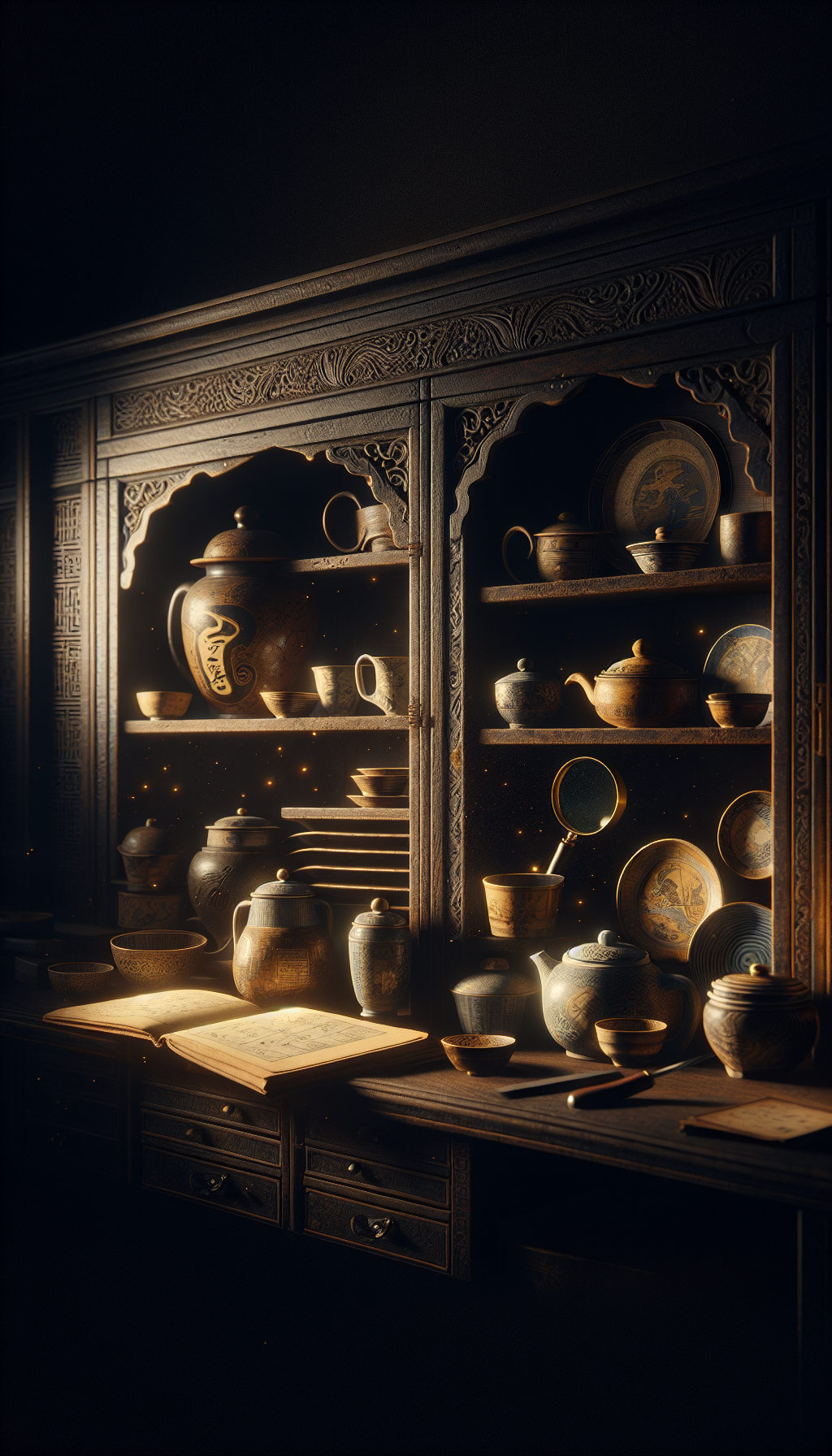Imperial Famille Rose Peach Signed
The phrase “Imperial Famille Rose Peach Signed” appears often in auction listings and dealer descriptions, yet it conflates several distinct ideas: imperial manufacture versus later copies, famille rose enameling, peach iconography, and the meaning of a “signature” on Chinese porcelain. This guide explains what the phrase should mean, how to evaluate such wares, and what separates genuinely imperial examples from later imitations.
What collectors mean by “Imperial Famille Rose Peach Signed”
- Imperial: Produced under direct court supervision for the Qing palace, typically at Jingdezhen’s imperial kilns, most notably during the Yongzheng (1723–35) and Qianlong (1736–95) reigns.
- Famille rose: The fencai/yancai palette introduced in the early 18th century using colloidal gold pink enamel and soft opaque colors, enabling subtle shading and Western-influenced modeling.
- Peach motif: Longevity peaches (shoutao) often with entwining branches and pink-blushed fruit; sometimes combined with bats (fu) for the rebus “wufu pengshou” (five blessings crowning longevity). The famous “Nine Peaches” vase is a hallmark Qianlong design.
- Signed: On imperial porcelain, “signed” almost always refers to reign marks (kaishu or zhuanshu script) such as Da Qing Qianlong Nian Zhi. Artisan signatures are rare on 18th–19th century wares and become common only in the Republic period (early 20th century) when studio painters wrote inscriptions and seals in enamels.
In short, a textbook “imperial famille rose peach” piece is a mid-18th century Jingdezhen product with refined fencai enameling and a period Qianlong or Yongzheng reign mark, executed to court standards. Many later wares bear apocryphal Qianlong marks, so the mark alone cannot establish imperial status.
History, iconography, and stylistic expectations
- Yongzheng (1723–35): The famille rose palette matures. Bowls and dishes with restrained peach sprays or interior medallions appear. Enameling is delicate, with restrained gilding, finely penciled outlines, and subtle pink shading.
- Qianlong (1736–95): Opulence increases. The “Nine Peaches” design on rouleau or tianqiuping vases becomes emblematic: gnarled brownish branch, complex foliage, and nine peaches varying from yellow ground to deep rose blush. Borders may include ruyi heads, bats, shou characters, or sgraffito scrolling on colored grounds (turquoise, yellow, pink). Gilding is more liberal than in Yongzheng.
- Daoguang to Guangxu (1821–1908): Strong revivalism. Peach-and-bat designs proliferate on bowls and dishes. Drawing can be charming but less naturalistic; enamels often brighter or chalkier, outlines heavier, and gilding more routine.
- Republic period (1912–49): High-quality studio work reinterprets famille rose with fine inscriptions and artist seals. Peach designs continue, sometimes highly naturalistic, sometimes decorative. Artisan signatures are now common.
Iconography clues:
- Peaches symbolize longevity; nine is an auspicious number, reinforcing the theme.
- Bats symbolize blessings (fu). Five bats with peaches signal “five blessings and longevity.”
- On high-grade imperial Qianlong peach vases, the branch snakes continuously around the body with changing perspectives; leaves show variegated greens with vein detailing and carefully modeled light-source shading.
How to authenticate: body, glaze, enamels, and painting
- Porcelain body and footrim
- Paste: 18th-century imperial paste is fine and compact, with few impurities. Under magnification, expect tight “sugar” but not porous grit. Color is clean white, sometimes with a faint bluish tinge.
- Footrim: Neatly cut and even, often with a slight inner bevel. Wear on genuine examples is smooth and consistent, not granular. Beware freshly abraded rims stained with tea or pigment to simulate age.
- Base: For white-ground vessels, bases are usually white-glazed with a centrally placed underglaze or overglaze mark. For colored grounds (turquoise, yellow, pink), the base may be covered in the ground color with an iron-red seal mark reserved in white or applied on the colored glaze.
- Glaze and firing
- Surface: A fine, glassy glaze with even pooling. Minute bubble structure should be random and not “orange-peel” pitted. On copies, glaze can look overly syrupy or unnaturally perfect and thick.
- Imperfections: Tiny kiln grit or pinholes are normal; large bubbles near the mark or sloppy glaze voids suggest later firing quality.
- Famille rose enamels
- Pink: Early famille rose pinks are built from minute dots and washes; under 10–20x magnification, look for a soft, slightly matte surface with subtle pitting and no plasticky gloss. Later enamels can look glassy and homogenized.
- Shading: On imperial peach fruit, blush transitions from warm yellow at the shoulder to rose/crimson at the cheek, with carefully retained highlights. The suture line is not a crude dark stripe.
- Leaves: Multiple greens with vein lines and occasional insect-nibbled margins; stroke work is confident and varied, not monotone.
- Outlines and gilding: Outlines are fine and precise. Gilding is thin and well adhered, not chunky. Extensive, brassy gilding with little wear can indicate later manufacture.
- Drawing and composition
- Qianlong nine-peaches vases: The branch curves around the body with continuous narrative; fruit vary in size and stage of ripeness; voids are intentional to balance weight. Many modern pieces copy the scheme but fail to integrate the branch convincingly around the form.
- Bowls and dishes: Bat-and-peach motifs on imperial bowls are crisp, with bats drawn in lively flight—wings defined by graded washes, not heavy cartoon outlines.
- Sound and weight (secondary checks)
- A clean ring suggests integrity but does not prove age. Weight should feel proportionate to size; heavy, clunky porcelain can indicate later manufacture, though some 19th/20th-century pieces are thin and deceptive.
Understanding marks and the idea of “signed”
Reign marks:
- Scripts: Six-character kaishu (regular script) or zhuanshu (seal script) “Da Qing Qianlong Nian Zhi.” Qianlong seal marks in iron red within a double square are classic on many famille rose wares.
- Placement: Centered within a neatly drawn double square or circle; spacing and stroke economy are consistent. Smudgy, off-center, or printed-looking marks are warning signs.
- Color: Underglaze blue marks are common on white bases; iron-red overglaze marks are common on colored bases and famille rose grounds.
- Apocryphal marks: Later pieces, especially Guangxu, Republic, and modern wares, frequently carry Qianlong marks out of respect or for commercial appeal. An apocryphal mark is not proof of deceit but must not be taken as evidence of period.
Artisan signatures:
- Qing imperial wares rarely carry painter signatures.
- Republic period studio painters (e.g., the “Eight Friends of Zhushan”) often inscribed poetry, dedications, dates (Republic year cycles), and red enamel seals. If your peach-decorated vase has a poem and seals, it is likely Republic or later, not 18th-century imperial.
Inscriptions and date clues:
- Cyclical dates (jiazi, yichou, etc.) paired with a studio name can anchor a piece to a Republic year.
- Dedications to named individuals are a Republic convention; imperial palace wares do not bear personalized dedications.
Appraisal factors: what drives value
- Period and authorship: A Yongzheng or Qianlong imperial peach piece of palace quality sits at the top of the market. Later Qing court-quality examples can be valuable, but generally less so. Republic studio masterpieces by known artists also command strong prices.
- Form and rarity: The nine-peaches tianqiuping or large rouleau vases are iconic; bowls and dishes are more common. Unusual forms (beaker vases, covered jars) can be rare and desirable if quality matches.
- Quality of painting: Naturalistic modeling, nuanced shading, and balanced compositions are critical. Mechanical gradients, airbrushed look, or stiff leaves depress value.
- Condition: Original, unrestored examples command premiums. Hairlines, star cracks, ground-down rims, heavy overpainting, and regilding reduce desirability—sometimes drastically.
- Mark, base, and foot: A correct period mark with congruent base treatment supports attribution. An imperial-quality body with a later-added mark raises red flags.
- Provenance: Documented history—collection labels, early literature mentions, or old photographs—adds confidence and value.
Values vary by orders of magnitude between genuine imperial, high-quality 19th-century, Republic studio, and modern copies. A cautious, evidence-based approach is essential.
Common pitfalls and modern reproductions
- Over-reliance on the mark: Many 20th/21st-century vases carry neat iron-red Qianlong seal marks. Always judge the whole: body, glaze, enamels, and painting.
- Airbrushed blush: Uniform peach gradients and powdery overspray edges suggest modern techniques. Qianlong shading is brush-built, with intentional highlights.
- Synthetic aging: Tea-stained footrims, sandpapered bases, and artificial “kiln grit” added into wet glaze. True wear appears random and smooth, not scratchy.
- Wrong calligraphy: Sloppy or stylized pseudo-seal script, incorrect stroke order, or poorly spaced characters. On Republic inscriptions, watch for anachronistic phrases presented as 18th century.
- UV traps: Modern bright-white restorations or fillers fluoresce intensely under UV; older enamels may show mild, even fluorescence or none. UV helps with condition, not with dating alone.
- Sgraffito and grounds: On imperial pieces with turquoise or yellow grounds, the incised scrollwork is controlled and rhythmic; modern copies often scratch randomly and unevenly.
Care, handling, and display
- Support the base, not the rim, when lifting. Avoid rings or bracelets that can chip enamels.
- Display away from direct sunlight; UV can fade enamels and degrade gilding over decades.
- Dust with a soft brush. If needed, use barely warm distilled water and a drop of neutral pH soap; avoid soaking and never use abrasives.
- Record condition under good light before and after any move. Photograph the base, footrim, and key motifs.
- For restoration, choose a conservator experienced with overglaze enamels; aggressive cleaning can strip gilding and pinks.
Quick field checklist
- Does the painting look alive? Varied brushwork, nuanced shading, and confident line control are good; stiff outlines and flat fills are not.
- Footrim even and well finished? Smooth, honest wear beats gritty, stained “age.”
- Enamels under magnification: fine, slightly matte, and micro-pitted (older) versus uniform, glassy, and slick (modern).
- Mark congruent with base treatment? Iron-red seal on turquoise/yellow base or underglaze blue on white base—well centered and well penned.
- Composition integrated around the form? On vases, does the branch flow continuously with varied fruit?
- Condition honest? Check for overpaint, regilding halos, and filled chips under raking light and UV.
FAQ
Q1: If a vase has a perfect iron-red Qianlong seal mark, is it imperial? A: Not necessarily. Apocryphal Qianlong marks appear on many later wares. Evaluate the entire piece—body, enamels, painting quality, footrim, and composition—before deciding.
Q2: Did imperial famille rose wares carry artist signatures? A: Almost never. Qing imperial porcelain typically bears reign marks, not painter names. Signed poems and seals in enamel point to Republic-era studio work or later.
Q3: How can I tell Yongzheng from Qianlong peach decoration? A: Yongzheng tends to be restrained, with delicate lines and subtle, pale pinks. Qianlong embraces richer color, fuller compositions (e.g., nine peaches), more elaborate borders, and often more gilding.
Q4: Are bats always present with peaches? A: No. Bats frequently accompany peach motifs on bowls and dishes, but the iconic nine-peaches vases usually feature peaches and branch alone without bats.
Q5: Can UV light prove age? A: UV is best for revealing restorations and overpaint. It cannot by itself determine age. Use it alongside close visual inspection, magnification, and comparative study.
By aligning mark, materials, and painting with historical expectations—and resisting the lure of a “signed” Qianlong mark as a shortcut—you can navigate the crowded market of “Imperial Famille Rose Peach” porcelains with greater confidence.




